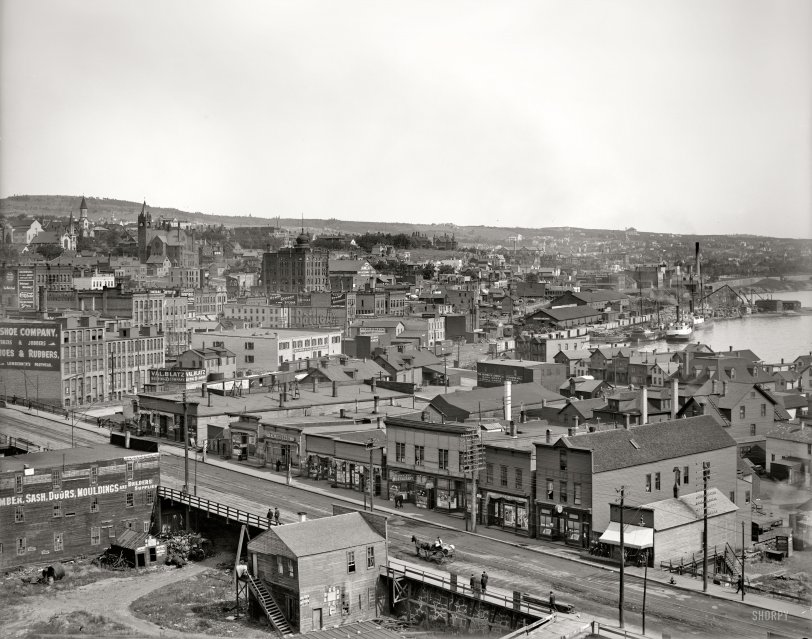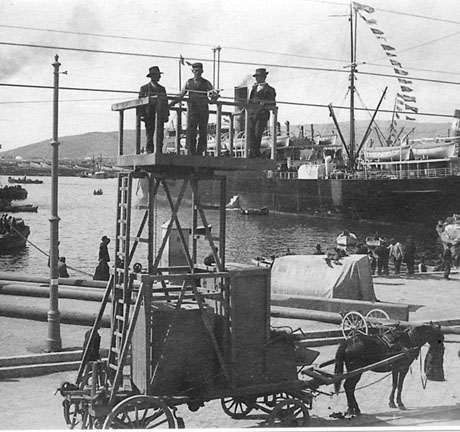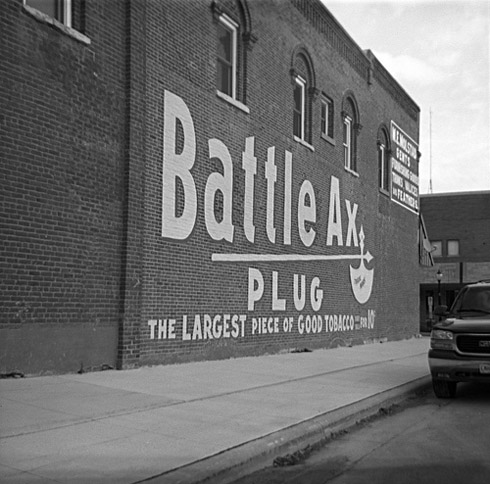


Framed or unframed, desk size to sofa size, printed by us in Arizona and Alabama since 2007. Explore now.
Shorpy is funded by you. Patreon contributors get an ad-free experience.
Learn more.

- Roll your own
- Rugged and real!
- A Charles Purcell - Mama Cass Connection
- Uncle SAAM
- Obfuscation
- One Chocolate Soldier rode away
- Victor Marquis de la Roche
- The Little House Across Way ...
- Vanderbilt Gates
- Vanderbilt Mansion
- You can still see that gate
- Withering heights for me
- So Jim,
- Top Heavy
- Re: Can't Place It.
- Bus ID
- Since you mention it
- The White Pages ?
- Moonlight Tower
- 1907?
- Fire(men) and Water
- Can't Place It
- Can anyone
- Wings
- Where's Claudette and Clark?
- Overbuilt Rolodex
- One song
- Give Me Wings Please!
- PRR
- Pinball Wizards
Printporium
Devine's Place: 1905

Circa 1905. Our latest installment from the Duluth, Minnesota, panoramic series. Anyone for a round of Blatz? Detroit Publishing glass negative. View full size.
Panoramic Duluth
Did the streetcar company have one of these?
I've just come back from holiday in Greece. Trams and trolley buses are alive and well in Athens and Pireaus. The modern trolley poles look pretty substantial, but here is a delightful 1910 photo (courtesy of the ISAP archives) of a horse drawn tower wagon for inspecting the tram wires on the Pireaus waterfront. The Duluth trolley poles at the right of your picture look very similar to the one on the left of this one and the insulator is indeed very small. I wonder if the Duluth streetcar company had such a handy vehicle?

A Battle Ax in Indianapolis
http://www-lib.iupui.edu/static/exhibits/circle/exhibit3_1.html
While on an entirely different expedition, I just came across another old photo showing a 'Battle Ax' mural, right here in my hometown. Thought I'd share...
http://www-lib.iupui.edu/static/exhibits/circle/exhibit3_1.html
Those trolley poles
I saw a couple of comments about the trolley wire infrastructure and I've lived in a city that still has streetcars my whole life, so hopefully I can clear a bit up:
The insulators don't look that big in the picture and they don't look that big from the ground either, when you're standing on the sidewalk looking up. The are substantial pieces of porcelain when you're holding one in your hand. Also, they only need to insulate against 600 volts DC, which isn't that high.
With respect to the support poles, they're probably painted steel poles. Notice that they are only carrying the span wires and trolley wires above the tracks as well as some DC feed circuits. They aren't carrying nearly as many circuits or heavy objects like transformers that the electric utility poles are. Poles like the ones in the picture have lasted between 60 and 80 years at home.
The support poles have to be installed on a slight angle, leaning away from the street, when they're installed because the tension of the overhead wires above the tracks and the span wires supporting them tends to pull the poles in towards the street. If you look closely at the support pole at the far right of the picture on the sidewalk closest to the camera, you can see it bending in towards the street. That suggests that it either wasn't installed correctly or (more likely from the way the pole appears bent) the span wire' tension's much too high...
Streetcar wire like that's one thing that hasn't changed much over the last 100 years and the stuff hanging above the tracks a block from where I'm writing this looks the same in 2009 as it does in the picture from 1905.
Points of interest
The large white building with the Star of David at the left edge of the photo is the local Orthodox synagogue in Duluth, still standing and in service.
The onion dome sits on top of the Masonic Temple Opera Building, built in 1889 on Superior Street. The dome was later removed so as not to "mock the Classic purity of the Orpheum Theater" being built next to it on the avenue, according to a local architectural guide.
Churchville
I can see at least four steeples in this shot as well as the building with the onion dome might be one (I am inclined to think it's a hospital or a school). Just how much "churchin'" did one town need?
Did anyone notice the Coca Cola sign on the left?
Also, judging by the size of some of the mansions in town, there was some serious money in Duluth at this time.
Stables!
Finally spotted a stable! J. Hammel & Co, sale and exchange stables. Would love to see a close up of it or other stables from long ago for that matter!
Flimsy trolley poles
The trolley poles are amazingly flimsy. They look like they're made out of steel water pipe. The insulators look about the size of those used for low voltage telephone wires. I can only see one street light (at the right) so it must have been dark at night. I don't think the trolley poles would survive a midnight collision with a hefty Scandinavian dock worker full of Blatz.
Star of David
I see a Star of David symbol in three locations: on the Blatz Brewery sign, on a storefront just to the right of the Northland Restaurant, and on the side of the large white building at upper left. Was there a significant Jewish presence in 1905 Duluth or does the symbol indicate something else?
[In Germany, the hexagram or Bierstern (beer star) was a symbol of the brewers' guild. - Dave]
Well engineered
The guy who designed the elaborate chimney flu on the building next to the hotel was determined to not let one tiny bit of rain or snow get down into the house.
[Achoo. - Dave]
Duluth had what this country needed
A good 5 cent cigar!
City Gas
Duluth must have had a municipal gas system in those days. Above the Blatz building you can see the frame for storage.
Fire!
In the middle left are the ruins of a building that looks like it burned down.
Norse Street
This looks like a real Scandinavian street, with the Scandinavien Boarding House, Svea Hotel, Northland restaurant and A.W. Anderson's shop. Maybe that's one of my immigrant great-grandfathers sitting under that awning.
I'm curious where the dirt road that goes under the bridge leads to, though.
Luxe accommodations
In just a single-block stretch of seven or eight storefronts there are the Scandinavien Boarding House, Zenith Lodging and the Sven (?) Hotel. And they all look a little rough around the edges. I imagine these fine establishments were most often frequented by merchant seamen coming ashore after crossing Lake Superior, before reloading the next day to head back east through the Great Lakes, perhaps all the way to the St. Lawrence Seaway. They were probably a little rough around the edges as well. Great photograph.
[The St. Lawrence Seaway didn't open until 1959. - Dave]
Battle Ax
was a brand of chewing tobacco. If "Mail Pouch" wouldn't turn off chaw customers, why would "Battle Ax"? A complete version of a wall painting, courtesy of Olivander's Flickr site, is below.

The beer made in Superior...
was Northern.
Duluth had a couple other breweries besides Fitger's Brewing (Fitger's & Rex Beer). Duluth Brewing & Malting (Royal Bohemian, Stag, Moose & Karlsbrau Beer) & Peoples Brewing (Peoples, Regal Beer, Olde English 600 Stout). All brand are gone except Olde English 600, which still lives on as Olde English 800 Malt Liquor.
Still standing
The dark church and the Fitgers smokestack are still there in this panorama: http://upload.wikimedia.org/wikipedia/commons/f/f9/Skyline-Duluth-200603... Now I have a hankering to visit Grandma's Saloon again for old time's sake. It was a day trip from my home town of Minneapolis, but it's a long ways from where I live in Texas now. Sigh.
Pleasantly Seedy
Notice how The Builder's Supply building in the foreground has a first floor below the road. I wonder if all of the buildings on the other side of the bridge approach - including Devine's Place - at one time had first floor storefronts and then the buildings were modified once the bridge was built.
Just a wonderful, wonderful picture.
I'm surprised
that Dave didn't name this photo "(S)hoes and rubbers" but that might have been just a too bit racy.
That street in the foreground
is probably the kind of place that your mom would tell you to never walk down.
I'll take a pass
on that Blatz. But I could really go for an ice cold Battle Ax!
Battle Ax -- The beer that made Duluth, well, Duluth!
Trolley wire
I have never seen a trolley wire suspension system like the one in the photo. Maybe there weren't enough wooden poles so they resorted to the iron poles and arches, but it would seem that insulation of the wires from the ground would be difficult. Anyone seen this system in any other Shorpy photos?
Well gosh
Now I have an urge to go grab me a chew of "Mail Pouch." Isn't advertising wonderful?
I'm buying but ...
it'll have to be the hometown Fitgers, or at least the cross-port rival, Superior.

























On Shorpy:
Today’s Top 5